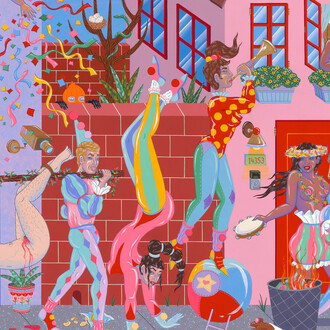The Fahey/Klein Gallery is pleased to present Arnold Newman, Portraits, an exhibition of works by one of the most influential portrait photographers of the 20th century. The exhibition of works from the 1940s through the 1970s will present a selection of Newman’s finest, most nuanced prints including striking portraits of artists Marcel Duchamp, Martha Graham, David Hockney, Willem de Kooning, Louise Nevelson, Isamu Noguchi, Georgia O'Keeffe, and Diana Vreeland.
Newman is generally acknowledged as the pioneer of the environmental portrait. He spent time exploring the essence of his subjects, finding the best environment to express who they were, and integrating them with their work into compositions that referenced the work. He structured his own visual language, setting up photographs with jaunty geometric grace and inventing visual elements where none existed thus adding complexity and depth to his portraits. His sense of tension, rhythm, and balance, guides the eye through his command of composition.
In 2018 Radius Books celebrated the centennial of Newman’s birth, with the release of their stunning hardback book, Arnold Newman: One Hundred. Gregory Heisler, Professor of Photography, Syracuse University, writes in his introduction to the book “Arnold Newman conceived a new vocabulary for photographic portraiture. It is difficult today to truly appreciate the magnitude of his breakthrough. Before Arnold’s arrival, the photographic portrait was generally a box with somebody in the center. Arnold used what was around him to create visually complex, spatially intriguing portraits that had a psychological dimension. He didn’t just show the environment, he actively employed it for its narrative power.”
Arnold Newman (1918-2006) was born in New York City. He began his career in photography in 1938 working at chain portrait studios in Philadelphia, Baltimore, and West Palm Beach, and immediately began working in abstract and documentary photography on his own. In June of 1941, Beaumont Newhall of the Museum of Modern Art, New York, and Alfred Stieglitz “discovered” him, and he was given an exhibition at the A.D. Gallery in September. In 1945 his Philadelphia Museum of Art one-man show, Artists Look Like This, attracted nationwide attention. Newman’s new approach to portraiture began its influence through key publications in America and abroad. Exhibitions and purchases of his work by major museums quickly followed.
Arnold Newman authored many books, including Bravo Stravinsky, 1967; One Mind’s Eye: The Portraits and Other Photographs of Arnold Newman, 1974; Faces USA, 1978; Arnold Newman: Five Decades, 1986; Arnold Newman’s Americans, 1992; Arnold Newman, in Japanese and Korean, 1992; Arnold Newman-Selected Photographs, 1999; Arnold Newman, Taschen Publishers, in English, German and French, 2000; Arnold Newman: The Early Work, Steidl publishers, 2008
He has been an important contributor of portraits, still-lives and photographic essays in such publications as Life, Holiday, Look, Vanity Fair, Scientific American, Town and Country, Esquire, Travel and Leisure, Harper’s Bazaar, The New Yorker and others.
Celebrating Newman’s 50th year in photography, the exhibition Five Decades originated and was first shown at the Museum of Photographic Arts, San Diego, in 1986, and continued on to the Art Institute of Chicago; the Minneapolis Institute of the Arts; the Massachusetts Institute of Technology Museum, Cambridge, MA; the Norton Gallery and School of Art, West Palm Beach, Fla.; the New York Historical Society, New York, the Modern Art Museum of Fort Worth; and the Cincinnati Art Museum. The European tour opened in Amsterdam, in September 1989, and continued on to the Joan Miro Foundation Museum, Barcelona, Spain; the Frankfurter Kunstverein, Frankfurt, Germany; the Musee de l’Elysee, Lausanne, Switzerland, and the Museum of Modern Art, Oxford, England, culminating in Tokyo and Osaka in 1993.
Five major museum retrospectives celebrated Newman’s sixty-year career in photography; the International Center of Photography, New York City, in March 1999; the Minneapolis Institute of Art, 2000; the Corcoran Gallery, Washington, D.C., 2000 (Arnold Newman: Breaking Ground); and Arnold Newman sponsored by the French Ministry of Culture at the L’Hotel de Sully, Paris, France, 2002. His work continues to be exhibited extensively in museums and galleries in the United States and abroad.
















